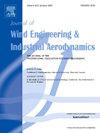利用扩散模型和注意机制的气象风场快速降尺度方法
IF 4.9
2区 工程技术
Q1 ENGINEERING, CIVIL
Journal of Wind Engineering and Industrial Aerodynamics
Pub Date : 2025-08-27
DOI:10.1016/j.jweia.2025.106215
引用次数: 0
摘要
气象风场数据的快速降尺度在极端天气预警、可再生能源评估与选址优化、核事故应急响应动态模拟等方面得到了广泛应用。本研究提出了一种渐进式深度学习降尺度模型(从0.25°降尺度到3 km),通过将扩散模型与多头交叉注意机制相结合,生成高分辨率风场数据。具体来说,开发了一个渐进扩散框架,通过对高斯噪声分布初始化的潜在状态进行迭代去噪来生成高分辨率风场。与具有梯度惩罚的WGAN-GP (Wasserstein Generative Adversarial Network with Gradient Penalty)架构相比,我们的方法实现了平均绝对误差(MAE)减少约32%,均方误差(MSE)减少46%,而结构相似指数(SSIM)从0.7显著提高到0.8以上。结果表明,该方法显著提高了生成质量,减轻了生成对抗网络(GAN)中模式崩溃引起的非物理伪影。多头交叉关注机制和2D旋转位置嵌入(RoPE)的集成可以有效融合来自低分辨率风场、地形数据和扩散模型潜在状态的交叉模态信息。消融研究表明,注意机制降低了MAE和MSE约20%,同时提高了峰值信噪比(PSNR)和SSIM值。这表明,注意机制使模型能够捕获远程空间依赖关系,显著增强了模型在空间特征重构中的表征能力和物理一致性。此外,为了解决传统扩散模型推理速度慢的问题,本工作实现了去噪扩散隐式模型(Denoising diffusion Implicit Model, DDIM)采样算法来实现确定性的潜在空间映射,在保持生成精度的同时大大减少了推理步骤。该框架最终实现了在数秒内快速生成高精度风场数据。该方法为气象风场降尺度提供了一种新的解决方案,可直接服务于需要精细气象数据的各种工程应用。本文章由计算机程序翻译,如有差异,请以英文原文为准。
A rapid downscaling approach for meteorological wind fields using diffusion models and attention mechanisms
Extensive applications have been found for rapid downscaling on meteorological wind field data in extreme weather warning, renewable energy assessment and site selection optimization, as well as dynamic simulation of nuclear accident emergency responses. This study proposes a progressive deep learning downscaling model (from 0.25° to 3 km) for generating high-resolution wind field data by integrating diffusion models with multi-head cross-attention mechanisms. Specifically, a progressive diffusion framework is developed to generate high-resolution wind fields through iterative denoising of latent states initialized from Gaussian noise distributions. Compared to Wasserstein Generative Adversarial Network with Gradient Penalty (WGAN-GP) architecture, our approach achieved approximately 32 % reduction in Mean Absolute Error (MAE) and 46 % reduction in Mean Squared Error (MSE), while Structural Similarity Index (SSIM) was significantly improved from 0.7 to over 0.8. It is deduced that this approach significantly improves generation quality and alleviates non-physical artifacts caused by the mode collapse within Generative Adversarial Network (GAN). The integration of multi-head cross-attention mechanisms and 2D Rotary Positional Embedding (RoPE) enables effective fusion of cross-modal information from low-resolution wind fields, terrain data, and diffusion model latent states. Ablation studies demonstrate that the attention mechanism reduced both MAE and MSE by approximately 20 %, while improving Peak Signal-to-Noise Ratio (PSNR) and SSIM values. This indicates that the attention mechanisms enable the model to capture long-range spatial dependencies, significantly enhancing its representational capacity and physical consistency in spatial feature reconstruction. Additionally, to address the slow reasoning speed of traditional diffusion models, this work implements the Denoising Diffusion Implicit Model (DDIM) sampling algorithm to achieve deterministic latent space mapping, substantially reducing inference steps while maintaining generation accuracy. This framework ultimately realizes rapid generation of high-precision wind field data within seconds. The proposed methodology provides a novel solution for meteorological wind field downscaling, directly serving various engineering applications requiring refined meteorological data.
求助全文
通过发布文献求助,成功后即可免费获取论文全文。
去求助
来源期刊
CiteScore
8.90
自引率
22.90%
发文量
306
审稿时长
4.4 months
期刊介绍:
The objective of the journal is to provide a means for the publication and interchange of information, on an international basis, on all those aspects of wind engineering that are included in the activities of the International Association for Wind Engineering http://www.iawe.org/. These are: social and economic impact of wind effects; wind characteristics and structure, local wind environments, wind loads and structural response, diffusion, pollutant dispersion and matter transport, wind effects on building heat loss and ventilation, wind effects on transport systems, aerodynamic aspects of wind energy generation, and codification of wind effects.
Papers on these subjects describing full-scale measurements, wind-tunnel simulation studies, computational or theoretical methods are published, as well as papers dealing with the development of techniques and apparatus for wind engineering experiments.

 求助内容:
求助内容: 应助结果提醒方式:
应助结果提醒方式:


